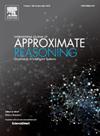Attention-based credible evidential segmentation network for remote sensing ship segmentation
IF 3
3区 计算机科学
Q2 COMPUTER SCIENCE, ARTIFICIAL INTELLIGENCE
引用次数: 0
Abstract
To address the challenges in ship segmentation arising from image quality degradation and edge blurring caused by adverse weather conditions and wave interference, this paper introduces the novel attention-based Credible Evidential Network, CEviCU-Net. Built upon Dempster-Shafer theory and the classical UNet architecture, CEviCU-Net consists of two main components: the feature extraction module and the evidential segmentation module. Specifically, the feature extraction module utilizes the U-shaped encoder-decoder framework. And this framework incorporates the Coordinate Attention Convolutional (CAC) module at the skip connection layers to extract semantic feature vector for each pixel. Subsequently, the evidential segmentation module in the CEviCU-Net employs a distance metric to compute the basic belief assignments (BBAs) between prototypes in the feature space and semantic feature vectors of each pixel. These BBAs are aggregated in the utility layer to facilitate semantic segmentation, accommodating the classification of ambiguous pixels and outliers. Finally, the model is trained end-to-end to jointly optimize all parameters of the proposed CEviCU-Net. Experimental results demonstrate the CEviCU-Net achieves the mIoU scores of 86.89% on the HRSID dataset and 90.43% on the Small ShipInsSeg dataset, representing improvements of 1.97% and 3.34% in average, respectively, compared to baseline models. These findings highlight the effectiveness of our proposed CEviCU-Net in the remote sensing ship segmentation.
基于注意力的可信证据分割网络遥感舰船分割
为了解决恶劣天气条件和波浪干扰引起的图像质量下降和边缘模糊给船舶分割带来的挑战,本文介绍了一种新的基于注意力的可信证据网络CEviCU-Net。CEviCU-Net基于Dempster-Shafer理论和经典的UNet体系结构,由两个主要部分组成:特征提取模块和证据分割模块。具体来说,特征提取模块采用u型编码器-解码器框架。该框架在跳跃连接层引入坐标注意卷积(CAC)模块,提取每个像素的语义特征向量。随后,CEviCU-Net中的证据分割模块采用距离度量来计算特征空间中的原型与每个像素的语义特征向量之间的基本信念分配(BBAs)。这些bba聚集在实用层中,以促进语义分割,适应模糊像素和离群值的分类。最后,对模型进行端到端训练,共同优化CEviCU-Net的所有参数。实验结果表明,CEviCU-Net在HRSID数据集上的mIoU分数为86.89%,在Small ShipInsSeg数据集上的mIoU分数为90.43%,与基线模型相比,平均分别提高了1.97%和3.34%。这些结果突出了我们提出的CEviCU-Net在遥感船舶分割中的有效性。
本文章由计算机程序翻译,如有差异,请以英文原文为准。
求助全文
约1分钟内获得全文
求助全文
来源期刊

International Journal of Approximate Reasoning
工程技术-计算机:人工智能
CiteScore
6.90
自引率
12.80%
发文量
170
审稿时长
67 days
期刊介绍:
The International Journal of Approximate Reasoning is intended to serve as a forum for the treatment of imprecision and uncertainty in Artificial and Computational Intelligence, covering both the foundations of uncertainty theories, and the design of intelligent systems for scientific and engineering applications. It publishes high-quality research papers describing theoretical developments or innovative applications, as well as review articles on topics of general interest.
Relevant topics include, but are not limited to, probabilistic reasoning and Bayesian networks, imprecise probabilities, random sets, belief functions (Dempster-Shafer theory), possibility theory, fuzzy sets, rough sets, decision theory, non-additive measures and integrals, qualitative reasoning about uncertainty, comparative probability orderings, game-theoretic probability, default reasoning, nonstandard logics, argumentation systems, inconsistency tolerant reasoning, elicitation techniques, philosophical foundations and psychological models of uncertain reasoning.
Domains of application for uncertain reasoning systems include risk analysis and assessment, information retrieval and database design, information fusion, machine learning, data and web mining, computer vision, image and signal processing, intelligent data analysis, statistics, multi-agent systems, etc.
 求助内容:
求助内容: 应助结果提醒方式:
应助结果提醒方式:


